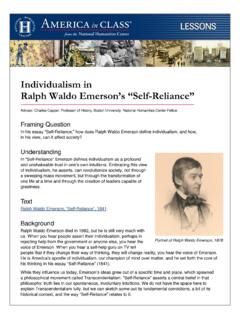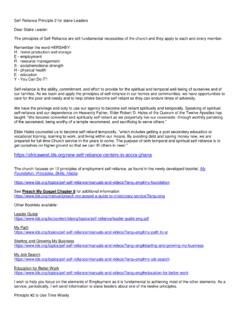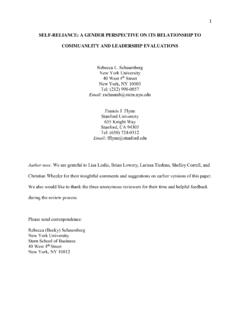Transcription of Self-Reliance Library - Temporary Services
1 The Self-Reliance Library is an autonomous readingand creating Library . It is a collection of older booksand reference materials that Temporary Services hasfound inspiring while doing our own projects andliving our lives. The Self-Reliance Library containsrecently published titles as well as out of print bookswe are just discovering. It includes a couple of ourown publications as well. The collection is designedto provoke the reader, solve creative problems, orsuggest imaginative directions for a range of in the Self-Reliance Library include: vision-ary architecture, desperate or wildly imaginativemobility, miniature architecture and nomadic living, self -publishing and design, everyday repair solu-tions, designs for fantasy worlds and alternate real-ities, technologies used in prisons and otherrestrictive or impoverished settings, ecologicallysound living, survivalism, weapon production forself defense or recreation, skill-sharing, and ap-proaches to living , Julia and Rick, Matthias, : Raumlaborberlin, 2008, 192 Labor is a platform run by a num-ber of people based in Berlin interested inmaking cities more open to experimentaltemporary uses.
2 Raum Labor has built anumber of exciting urban structures frominflatable shells attached to shipping con-tainers for small exhibitions to woodentowers for viewing and using city spacesin new ways. The group'sSpacebusterisa truck from the back of which a large in-flatable structure emerges and accommo-dates up to 80 people. It can easily bemoved around for various events andgatherings. This book is filled with ideasfor transforming "underestimated" urbanspaces in inspiring Their Own: People andthePlacesTheyBuildWampler, Jan. New York: Oxford Uni-versity Press, 1978, 206 richly-illustrated book surveys ar-chitecture based on the desires of peo-ple and includes inventive homes andmonuments by numerous creators in-cluding David Brown, Everett Knowlton,Art Beal, Romano Gabriel, FatherMatthias Wernerus, and Fred of their structures are ac-companied by small, neatly labeled dia-grams that show the overall layout ofthese often dazzlingly complex, ornate, orsprawling buildings and of the builders included are quotedalongside their works, talking about ap-proaches that often reflect a strong spiritof Self-Reliance and self -education.
3 Cre-ative recycling of cast off materials is acommon feature of many of the build-ings. More than a few of the structuresare cumulative and have evolved over aperiod of many years. Maude Meagherand Carolyn Smiley of Los Gatos, Cali-fornia state, We know nothing whateverabout building. We had never done anyrough work. One of us was a writer, theother a lecturer and educator with bookbinding and amateur movies as her hob-bies. But we both had college degrees,and we assumed that since primitive peo-ple can build their own adobe houses, wecould too, if we put our minds to it, solv-ing each problem as it came up. AntFarm:1968-1978 Lewallen, , , CA: University of CaliforniaPress, 2004, 212 Ant Farm crew were amazing vision-aries in all the things they were grounded in the counter cul-ture of the late 1960s and early may be part of the reason their workdid not get much critical attention untila few years ago. This book gathers to-gether many of their projects. They wereactive in guerrilla television, making in-flatable structures on a massive scale, de-signing bizarre buildings, creating mediaspectacles, and networking Hippiesacross the land into alternative communi-cations structures.
4 Ant Farm buriedCadillac cars in the desert and crashedother cars through walls of burning tele-visions. They made lush drawings ofutopian cities and architecture, producedgorgeous posters laying out their ideas forothers to copy. Their work remains freshand inspiring. If only more artists had theguts and the vision these folks had, lifewould be a lot more , Peter, ed. NewYork, NY: Prince-tonArchitectural Press, 1999, 152 started as a broadsheet pub-lished in London in 1961 by a group of ar-chitecture graduates. From the 1960sthrough about 1972 Archigram articu-lated a wild range of futuristic ideas4using graphics, drawings, collages, mod-els, and multi-media 's members were Peter Cook,Warren Chalk, Dennis Crompton, DavidGreene, Ron Herron and Mike highly inventive ideas included a"Walking City" composed of movingbuildings with telescoping legs, a "Plug-In City" with capsule homes, systems ofliving pods, and so much more. This com-prehensive book contains many examplesof the group's writings and work, oftendrawn from their publications.
5 Theirideas remain ripe for new , ,Japan:DHPub-lishing, 2008, 80 slender book consists primarily ofvibrant color photographs of dekotora or decorated trucks gleaming, highlyilluminated and heavily airbrushedchrome monsters that were inspired byextravagant vehicles shown in the 1975 Japanese filmTruck Yaro!The trucksare commonly hybrids of other truckswith limitless accessorizing that recall thecomplexities of Transformers toys mixedwith the flashing lights and gleamingmetal of a classic pinball machine or adazzling disco. The airbrushed imagery,that ranges from peaceful dolphins todramatic renderings of characters fromNoh theater, recalls the public paintingsseen on the sides of vans in the , ,IL:ChicagoReview Press, 2001, 192 how-to guide for making potato can-nons, paper match rockets, Cincinnatifire kites, tennis ball mortars, and moredynamite devices. In addition to materi-als lists and lessons in physics, historicalcontext is included for many of the itemsdescribed.
6 Don t shoot your eye out orburn down your neighbor s home!BikesofBurdenKemp, ,China:Vision-aryWorld Ltd., 2003, 160 book of 150 color photos by HansKemp documents extraordinary uses ofmotorbikes on the streets of fencing, dead pigs, dozens of chick-ens, doors, truck tires and entire familiesare shown being transported on singlebikes. These documents of everyday laborand survival evoke a sense of wonder andcomplete , ,NJ:The Scarecrow Press, Inc., 1967, 474 are the original mobilestructures and an obsession of ours. Theytake libraries and put them on wheels inorder to provide better access to ideas, re-sources, and information for wider audi-ences. They are particularly importantfor people in remote areas or with disabil-ities. These inspiring structures have beenwith us for a very long time. This book isfilled with great images of everythingfrom Civil War era mobile librariespulled by horses to libraries in Germanyin the 1930s with walls that expand withthe flip of , Carlos.
7 Mexico City, Mexico:Gomez-Gomez Hnos. Editores, 44 succinct publication that shows how tocut and fold paper or cardboard to make20 different three-dimensional geometricshapes; the book is a tool that can be usedwith young children or adults to buildcomplex structures. One could easily usean opaque projector to transfer the papercutting and folding patterns onto largecardboard sheets to create giant three di-mensional ,Torrey,Bland,Marco,andothers,Washington State Penitentiary. WallaWalla,WA: J. G. Narum, 2004, 164 cookbook was a class project by con-victs at the Washington State Peniten-tiary (WSP) in Walla Walla, presents recipes by prisoners at WSPalong with relatives and friends of pris-oners, correctional officers, instructors,and prison volunteers. The recipes byprisoners for in-cell dishes often de-pend on the limited range of ingredientsthat come from the prison store or snackbar as well as methods for cooking andpreparing those ingredients that can beachieved inside a cell.
8 As a result, someof the recipes feature unusually creativeapplications of highly generic ingredientsand recipes for items like cookies that canbe produced without baking. Other hotfoods, such as an omelet prepared in a Zi-ploc bag, depend on boiling water and animmersion heater one of the few cook-ing d evices that prisoners are often per-mitted to have in their cell. The bookincludes some methods of replacing pop-ular products like Swiss Miss Hot Choco-late mix with ad hoc versions combiningmore commonly found ingredients. Aglossary of convict slang at the WSP isalso cr atif(HomemadeRecordSleeves)Caillet, Patrice. Montreuil, France: di-tions Bricolage, 2009, 240 book expands upon the earlierRecreational Discographic swith a largerpage format and all new R cr atiffocuses on theamateur inventiveness found in hand-made or hand-altered vinyl record cov-ers. Many strategies are shown in fullcolor from a great trove of used recordstore discoveries. In addition to the usualoverdrawn photos with anatomical em-bellishments (male recording artiststurned into women, and vice versa) aremore than a few beautiful creationswhere the jacket was missing so an en-tirely new cover was created, or a plainwhite sleeve was heavily decorated withpainting, drawing, collage or a combina-tion of the three.
9 While some of these de-signs are casual or irreverent, many moreshow a fanatical excitement for musicand records that results in an entirelynew kind of graphic design and packag-ing art. Imagine the world we would livein if consumers redesigned all kinds ofpackaging with this level of interest andenthusiasm!DoItYourself:AHandbookForC hangingOurWorldTrapese Collective, , MI:Pluto Press, 2007, 306 Freire, the Brazilian educator andtheorist, once said that education itself isthe practice of members of the Trapese Collective,three longtime self -identified radical ed-ucators, have practiced the freedom tocreate change amongst others. Theyshare their hits, misses, advice, and read-ing lists in 2007'sDo It Yourself. This is aguide to many facets of sustainable living,including energy consumption, self -orga-nizing, cultural activism, and organizingaround health-care. It's filled with inspir-ing stories of change and resistancealongside practical step-by-step direc-tions for building everything from a com-posting toilet to a consensus-basedcommunity group.
10 The goal is the activ-ity that one feels spurred toward afterreading the basics inDo It does seem possible after seeingconcrete examples of the work that ama-teurs, citizens, and experts alike have :1980-89 Davis, Bert and Holly. Bloomington, IN:Microcosm Publishing, 2008, 164 :1990-1999 Davis, Bert and Holly. Bloomington, IN:Microcosm Publishing, 2009, 168 :2000-2008 Davis, Bert and Holly. Bloomington, IN:Microcosm Publishing, 2009, 168 pp."The advice in this book is taken frompersonal experience. It is not intended tobe a stand-alone survival guide. It 's upto you to decide what is right in your s it-uation."Dwelling Portablywas originally pub-lished by Bert and Holly Davis as a seriesof small zines over 28 years. They used atypewriter for text and hand drawn im-ages for their tidy, packed made the zines as they lived a no-madic life in the woods of the PacificNorthwest of the United States. The zineshows tips and strategies for living a fru-gal, low-impact, nomadic life.









